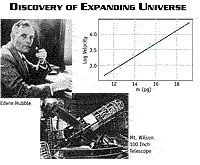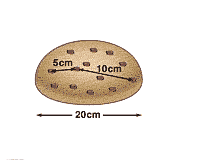
Tests of Big Bang: Expansion
Edwin Hubble
 The Big Bang model was a natural outcome of Einstein's General Relativity as applied to a
homogeneous universe. However, in 1917, the idea that the universe was expanding was
thought to be absurd. So Einstein invented the cosmological
constant as a term in his General Relativity theory that allowed for a static
universe. In 1929, Edwin Hubble announced that his observations of galaxies outside our
own Milky Way showed that they were systematically moving away from us with a speed that
was proportional to their distance from us. The more distant the galaxy, the faster it was
receding from us. The universe was expanding after all, just as General Relativity
originally predicted! Hubble observed that the light from a given galaxy was shifted
further toward the red end of the light spectrum the further that galaxy was from our
galaxy.
The Big Bang model was a natural outcome of Einstein's General Relativity as applied to a
homogeneous universe. However, in 1917, the idea that the universe was expanding was
thought to be absurd. So Einstein invented the cosmological
constant as a term in his General Relativity theory that allowed for a static
universe. In 1929, Edwin Hubble announced that his observations of galaxies outside our
own Milky Way showed that they were systematically moving away from us with a speed that
was proportional to their distance from us. The more distant the galaxy, the faster it was
receding from us. The universe was expanding after all, just as General Relativity
originally predicted! Hubble observed that the light from a given galaxy was shifted
further toward the red end of the light spectrum the further that galaxy was from our
galaxy.
The Hubble Constant
 The specific form of Hubble's expansion law is important: the speed of recession is
proportional to distance. Hubble expressed this idea in an equation - distance/time per megaparsec. A megaparsec is a really big distance (3.26 million light-years). The expanding raisin bread model at left illustrates why this proportion law is
important. If every portion of the bread expands by the same amount in a given interval of
time, then the raisins would recede from each other with exactly a Hubble type expansion
law. In a given time interval, a nearby raisin would move relatively little, but a distant
raisin would move relatively farther - and the same behavior would be seen from any raisin
in the loaf. In other words, the Hubble law is just what one would expect for a
homogeneous expanding universe, as predicted by the Big Bang theory. Moreover no
raisin, or galaxy, occupies a special place in this universe - unless you get too close to
the edge of the loaf where the analogy breaks down.
The specific form of Hubble's expansion law is important: the speed of recession is
proportional to distance. Hubble expressed this idea in an equation - distance/time per megaparsec. A megaparsec is a really big distance (3.26 million light-years). The expanding raisin bread model at left illustrates why this proportion law is
important. If every portion of the bread expands by the same amount in a given interval of
time, then the raisins would recede from each other with exactly a Hubble type expansion
law. In a given time interval, a nearby raisin would move relatively little, but a distant
raisin would move relatively farther - and the same behavior would be seen from any raisin
in the loaf. In other words, the Hubble law is just what one would expect for a
homogeneous expanding universe, as predicted by the Big Bang theory. Moreover no
raisin, or galaxy, occupies a special place in this universe - unless you get too close to
the edge of the loaf where the analogy breaks down.
The current WMAP results show the Hubble Constant to be 71.0 ± 2.5 (km/sec)/Mpc. If the WMAP data is combined with other cosmological data, the best estimate is 70.4 ± 1.4 (km/sec)/Mpc.
